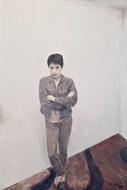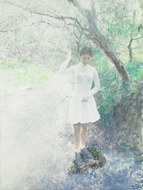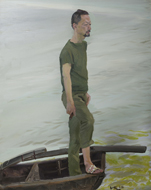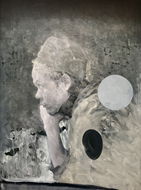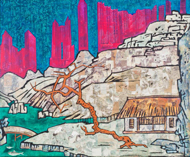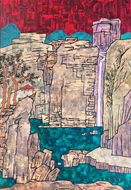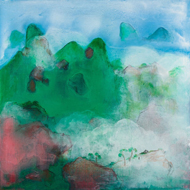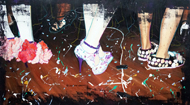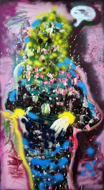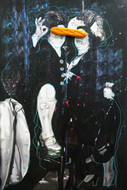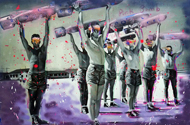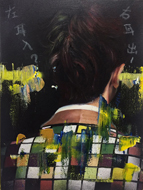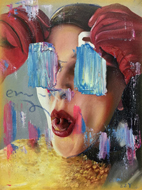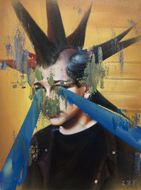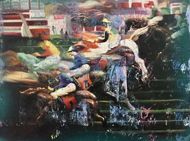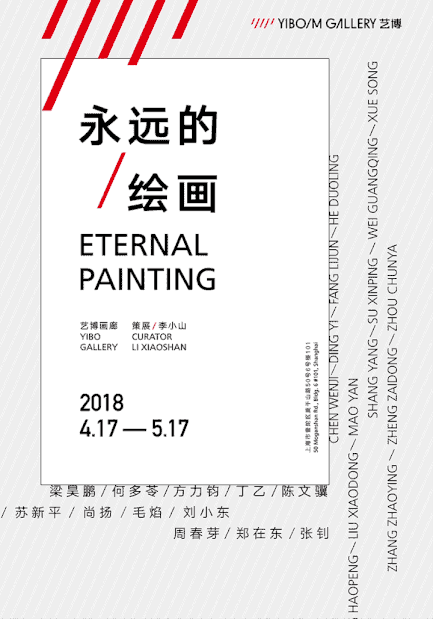
我常常听到一种说法,在当下,中国艺术家在国际艺坛最拿得出手的就是绘画。姑且不论这个说法是否符合事实,至少说明,很多中国的艺术家对绘画底气十足、自信满满。需要强调,这里所指的绘画当然不是本土的传统绘画——因为传统绘画缺乏参照,它是自我封闭的,自给自足的;它有自己的受众,有自己的一方天地。既然艺术家这么有底气、有自信,值得我们深入检视,底气和自信建立在什么基础上?我发觉一个有趣的现象,很多时候,艺术家喜欢玩逻辑漂移,每当谈及中国当代绘画的贡献何在,他们便会说,绘画创作纯属个体的事情,个体与个体不可比较,比较本身便是荒唐。然而谁都知道,没有比较哪来高低优劣?哪来“在国际上拿得出手”这一说法?你信不信?把一个自认为高高在上的艺术家搁在一个他们完全看不上眼的场合,他们会很生气,结果会很严重。
所以,艺术家个体永远是正确的,正确的个体又永远处在被“比较”的参照系中——并且在无情的“比较”之下,个体的“正确”经常显得毫无意义。现实告诉我们,无论对艺术家,还是对艺术家评价,这样的悖论无法避免。人们希望对某个事物进行确证,总能够在漫无边际的现实里找到一些必要的条件(或者说充分的条件),为认知提供标准。我得赶紧补充,在艺术上(或者说所有人文学科上),客观的标准是没有的,甚至连客观都是没有的。标准自然只是风尚、价值和趣味的总和。举例说,梵高再活多点时候,就能享受到艺术带给他的荣誉和财富,因为在梵高时代,社会风尚、价值和趣味不足以接纳他,也不足以接纳他的艺术。而稍后一点,毕加索和他的时代,新即美,新即好,毕加索便左右逢源、如鱼得水了。这说明,艺术家生逢其时,对于艺术家个体而言,关系重大。
完全可以说,近一二十年来,中国当代艺术家(特别是从事绘画的人)是确确实实生逢其时,特别是所谓的一线艺术家,他们斩获了超高的荣誉、名声和财富,转而滋生出超高的自信和自豪。当然,大家也知道,其中有为数不少的人搭了顺风车。论才华、论境界、论见识,他们都没有达到与荣誉、名声和财富相匹配的段位,偏能一而再、再而三地胜出,屹立不倒,也是值得人们深思的事情。话得说回来,既然生逢其时,就一切皆有可能。回想三十年前,正是这群有志于艺术的年轻人,胸怀理想,愈挫愈勇,经受了各种压抑和打击,坚持了下来,此时心安理得收获果实,难道不是顺理成章?不要忘了,相比以往任何时代,我们已处在“全球化”、“地球村”时代。尽管我们曾经封闭和僵化,但是东方不亮西方亮,墙外开花墙内香,通过时间转换慢慢生成了新的现实,现在终于到了自己蓄水养鱼的时候了。
参与本次展览的艺术家在年龄、阅历和作品面貌上的差距很大,像一面镜子,折射出绘画的现状、它的成就及可能性。我乐观地相信,里面少量的艺术家已经拿到了进入艺术史的入场券。他们是目前中国绘画的天际线——中国绘画应该有的和实际有的究竟是什么,大致上看得出端倪了。说到艺术史,其实比较虚幻,看你以什么样的长度来衡量:五十年?一百年?还是更长久?正如任何事物一样,艺术似乎也逃不出周期的影响。我的意思是,无论个体还是群体,都在时间的曲线上。一些人上升,一些人滑落,是正常不过的事。我常常替我的朋友惋惜、着急,明明已经才思枯竭,还在一门心思拼死拼活,所做的工作与艺术沾不上边,仅仅保持了一个姿态,让鼓起的钱袋更加鼓起一点而已。假如他们敢于放弃,干点别的,哪怕就是安度晚年,反而会使曾经的功勋格外耀眼,成全一段令人津津道来的江湖佳话。至于年轻一代,他们处在秩序、环境、价值、风尚逐渐固化起来的现实里。外部生态越来越嘈杂和平庸,内在的脉象又显得不那么强劲——他们能否续写前辈们“拿得出手”的篇章,只能由时间来证明了。
李小山
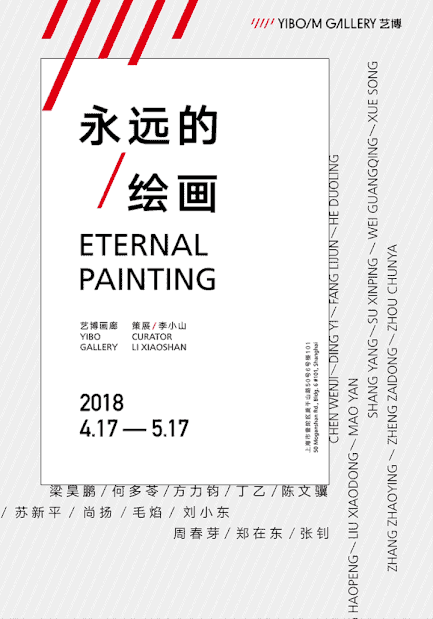
I often hear people say that, on the international art stage at the moment, Chinese artists are most recognized for paintings. Regardless of whether this statement is true, it shows that many Chinese artists have full confidence in painting. It is important to point out that the ‘painting’ referred here is not classical Chinese painting, which lacks reference points as it has its own audience; it is self-sufficient and self-enclosed. Since artists are so confident, it’s worth exploring where the root of this confidence stems from. I have observed an interesting phenomenon: often times, artists like to play logic games. Whenever we discuss the achievements of Chinese contemporary painting, they would say, “artistic creation is purely individual. It’s impossible to compare the individuals. The comparison itself is absurd.” But without comparison, where do good and bad come from? Why do we say certain works can be “recognized internationally”? If an artist is placed in a situation one deems as beneath oneself, the result is often catastrophic.
So, the artist is always correct, but each individual artist is always in a comparative frame of reference—under ruthless comparisons, the “correctness” of the individual is meaningless.Reality tells us that this paradox toward artists and their criticisms is unavoidable. People wants affirmations, and can thus always find necessary conditions (or more precisely, sufficient conditions), to provide a standard and criterion for cognition. I have to add that, in art (or in all disciplines of humanities), there can be no objective criterion of objectivity. Objectivity is nonexistent, the criteria are based on a combination of trend, value, and interest. For example, if Van Gogh had lived longer, he could have enjoyed the respect and wealth brought to him by his art. But at the time, social trend, value, and interest were unable to recognize his art. Later, for Picasso and his contemporaries, when newness was considered beautiful and desirable, Picasso easily achieved success. Thus, it can be said that for artists it is important to live in opportune times.
For the past two decades, contemporary Chinese artists (especially painters) are truly living in good moments—particularly the so-called frontline artists.They have attained high honors, fame, and wealth, and in turn developed high confidence and pride. We all know that many of them are piggybacking;their talents, state of thoughts, knowledge and experience have not yet matched their fame or wealth, but it's interesting that they never fall off the pedestal.Other wise, anything is possible in this opportune time. Thirty-years ago, it is this same group of ambitious young people, who have faced and fought against oppression. Isn’t it as a matter of course to reap the fruit of their labor? Compared to any other generations, we’re already in the era of “globalization.” Despite the fact that we were closed and restricted in the past, time has slowly changed our realities; it is time to let our fish grow.
The artists participating in this exhibition range greatly in their age, experience, and artworks. Like a mirror, the exhibition reflects the realities, achievements, and possibilities of painting. I optimistically believe that a few of these artists have obtained the tickets to enter into the hall of art history. Combined, they show the skyline of painting in China—a glimpse into the actual state of painting. Speaking of art history, it is also a vague term to quantify, as it depends on the system of measurement: is it 50 years? A century? Or is it longer? Like everything else in the world, art cannot escape the cyclical effect. No matter an individual or a group of people, everything is on the curve of time. Some move up, some slide down, this is all normal. I often worry and feel sorry for my friends—it is obvious that they have exhausted their talent and creativity, but they desperately produce works that are no longer art. They merely retain the attitude and make a living. If they were brave enough to give up, to do something else, or even to retire, their past feats would shine even brighter. For the younger generations who live in a world with a more set order, environment, value, and trend—when the external ecosystem becomes more and more noisy and mediocre and the inner pulse is faint, only time will tell if they could create “recognized works” to continue the chapters of their predecessors.
Li Xiaoshan



